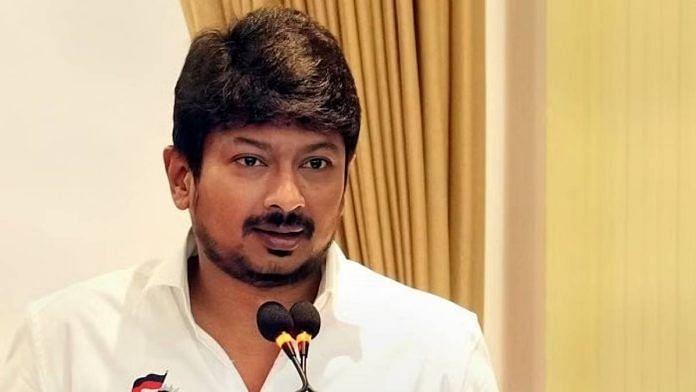Tamil Nadu Chief Minister’s son Udhayanidhi Stalin has stirred up a hornet’s nest by announcing his intent to “eradicate Sanatana Dharma”, whatever that means. He made that remark while addressing the Sanatana Abolition Conclave organised by the Tamil Nadu Progressive Writers Artists Association in Chennai on 2 September. The conference, which had the agenda of eradicating Hinduism, was also attended by Communist leaders and members of the Dravida Munnetra Kazhagam.
The DMK scion’s irresponsible and highly objectionable statement has increased fissures in the opposition group. The Congress, Trinamool Congress (TMC), and Aam Aadmi Party (AAP) have already distanced themselves from the DMK protégé’s statement. Whatever the other opposition parties may say now, immense damage has already been done. The so-called Dravidian parties have been part of both the National Democratic Alliance (NDA) and United Progressive Alliance (UPA) coalition at the Centre in the past.
These parties lost their political utility and leverage in 2014 when the Bharatiya Janata Party (BJP), under Prime Minister Narendra Modi’s leadership, emerged as the single-largest party to form the government on its own. The BJP’s lack of local leadership and party organisation at the grassroots in Tamil Nadu has kept the DMK’s political pot boiling till now. The status of the Congress is even worse, as it has been unable to stage a comeback in over five decades.
The DMK appears to be emboldened by the total absence of opposition at the political level in Tamil Nadu. But the party should understand that at the socio-cultural level, the state is no different from the rest of India. There is a strong undercurrent of pro-Hindu sentiment in the country, which could snowball into resentment against anti-Hindutva outfits and parties in the states. The DMK scion and his fellow travellers should know that Sanatana Dharma is not a political creed that can be defeated in an election.
Also read: Udhayanidhi Stalin’s remarks show dynastic privilege hides behind social justice slogans
Sanatana Dharma isn’t a ‘religion’
In fact, the Sanatana Dharma that the DMK and the leftover Left are seeking to destroy is not even a religion. It is an umbrella term signifying a conglomeration of various philosophies, forms and methods of worship loosely woven into the fabric of Hinduness. The word ‘Sanatana’ indicates something that is eternal and which always remains unchanged and unaffected. Again, the term ‘Dharma’ does not mean religion and should not be confused with any form of worship.
Dharma is a very wide concept with no equivalent term in English. By virtue of being a complex phenomenon, Dharma becomes incapable of definition. The closest explanation is that it is the distilled form of a huge array of ancient literature and commentaries by scholars in pursuit of truth.
Those who wish to annihilate Sanatana Dharma should try and understand that these two words were juxtaposed to appear to be indicating a religion. One cannot expect a mediocre political novice and a nonentity in social engineering to understand complex concepts that he and his party seek to destroy. These statements are being made to consolidate the party’s vote bank, which appears to be slipping away.
Also read: Udhayanidhi’s ‘eradicate Sanatana’ not a call to genocide. It’s internal critique of Hinduism
How DMK came to power
The DMK had its origin in the Dravidar Kazhagam, a social movement founded by EV Ramasamy Naicker (EVR) in 1944. Earlier, he was a part of the Self-Respect Movement that he started in 1925 and also worked with the Justice Party, which was founded immediately after the 1917 October Revolution in Russia. All these outfits merged to form the DK. Besides opposing caste structure among Hindus, the outfit also spearheaded the “separate Tamil Nadu” movement.
On their part, the British encouraged the DK and its leadership to challenge the Congress during its Independence struggle. What had begun as the Self-Respect Movement soon developed into an anti-Brahminism movement — DK members started destroying temples and breaking idols of Hindu gods and goddesses as standard operating procedures. The DK also supported the British, and its leader called for observing Independence Day as ‘black day’ to denounce freedom.
Besides anti-Hinduism activities, the DK carried out violent protests against Brahmins who overwhelmingly turned toward the Congress party for support and survival. After 1947, the Congress gained popularity and came to power in the state. The Chief Minister of erstwhile Madras State from 1952 to 1954, C Rajagopalachari or Rajaji, quit the Congress in 1959 and promoted a united anti-Congress opposition platform under the leadership of DMK veteran CN Annadurai. Rajaji, also a prolific writer on Hinduism, Ramayana, and Mahabharata, introduced compulsory study of Hindi in schools and the Madras Scheme of Elementary Education, which advocated traditional hereditary skills, virtually promoting caste hierarchy.
Ironically, a Brahmin and veteran Congress leader was singularly responsible for catapulting the atheist Dravidian party to power in 1967. Nearly 56 years later, it is the DMK chief minister’s son who wants to eradicate Sanatana Dharma — the philosophy whose ardent proponent’s misplaced generosity brought his party to power.
There are no more such stalwarts in the Tamil Nadu Congress who can steer the party away from such dubious elements that are sure to be consigned to the dustbin of history. The BJP, on its part, seems to be gaining ground and is likely to improve its position in the electoral arithmetic. If the Congress gathers enough guts to jettison the albatross around its neck, it may survive and even be able to stage a comeback in Tamil Nadu politics. Looks difficult, given the hollow nature of its apex leadership.
Seshadri Chari is the former editor of ‘Organiser’. He tweets @seshadrichari. Views are personal.
(Edited by Humra Laeeq)






